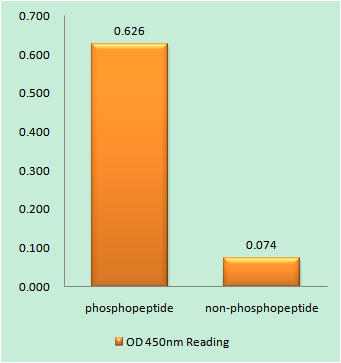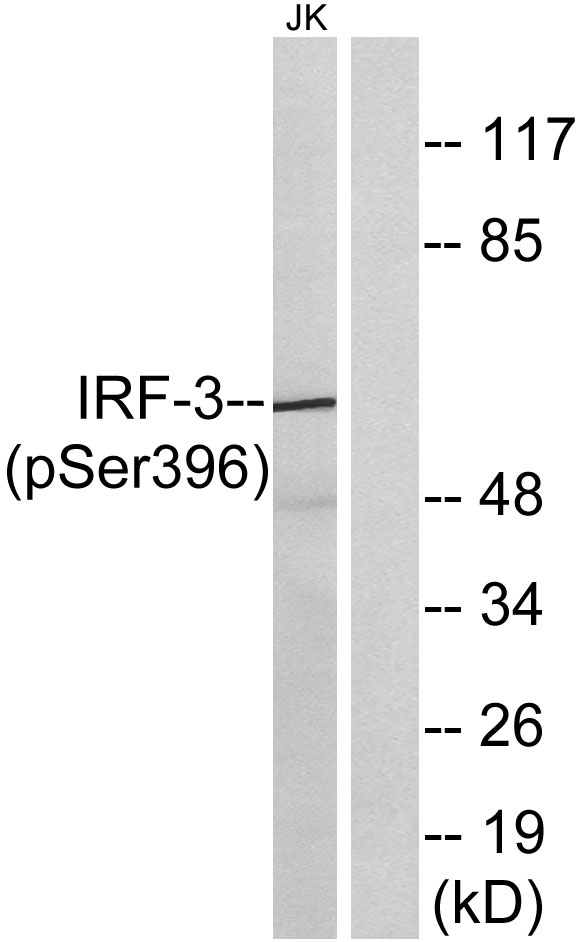IRF-3 (phospho Ser396) Polyclonal Antibody
- Catalog No.:YP0326
- Applications:WB;IHC
- Reactivity:Human;Mouse;Rat
- Target:
- IRF-3
- Fields:
- >>Toll-like receptor signaling pathway;>>NOD-like receptor signaling pathway;>>RIG-I-like receptor signaling pathway;>>Cytosolic DNA-sensing pathway;>>Alcoholic liver disease;>>Shigellosis;>>Pertussis;>>Yersinia infection;>>Hepatitis C;>>Hepatitis B;>>Measles;>>Human cytomegalovirus infection;>>Influenza A;>>Human papillomavirus infection;>>Kaposi sarcoma-associated herpesvirus infection;>>Herpes simplex virus 1 infection;>>Epstein-Barr virus infection;>>Human immunodeficiency virus 1 infection;>>Coronavirus disease - COVID-19;>>Viral carcinogenesis;>>Lipid and atherosclerosis
- Gene Name:
- IRF3
- Protein Name:
- Interferon regulatory factor 3
- Human Gene Id:
- 3661
- Human Swiss Prot No:
- Q14653
- Mouse Gene Id:
- 54131
- Mouse Swiss Prot No:
- P70671
- Immunogen:
- The antiserum was produced against synthesized peptide derived from human IRF-3 around the phosphorylation site of Ser396. AA range:362-411
- Specificity:
- Phospho-IRF-3 (S396) Polyclonal Antibody detects endogenous levels of IRF-3 protein only when phosphorylated at S396.
- Formulation:
- Liquid in PBS containing 50% glycerol, 0.5% BSA and 0.02% sodium azide.
- Source:
- Polyclonal, Rabbit,IgG
- Dilution:
- WB 1:500-2000;IHC 1:50-300
- Purification:
- The antibody was affinity-purified from rabbit antiserum by affinity-chromatography using epitope-specific immunogen.
- Concentration:
- 1 mg/ml
- Storage Stability:
- -15°C to -25°C/1 year(Do not lower than -25°C)
- Other Name:
- IRF3;Interferon regulatory factor 3;IRF-3
- Observed Band(KD):
- 48-55kd
- Background:
- This gene encodes a member of the interferon regulatory transcription factor (IRF) family. The encoded protein is found in an inactive cytoplasmic form that upon serine/threonine phosphorylation forms a complex with CREBBP. This complex translocates to the nucleus and activates the transcription of interferons alpha and beta, as well as other interferon-induced genes. Alternatively spliced transcript variants encoding multiple isoforms have been observed for this gene. [provided by RefSeq, Nov 2011],
- Function:
- function:Mediates interferon-stimulated response element (ISRE) promoter activation. Functions as a molecular switch for antiviral activity. DsRNA generated during the course of an viral infection leads to IRF3 phosphorylation on the C-terminal serine/threonine cluster. This induces a conformational change, leading to its dimerization, nuclear localization and association with CREB binding protein (CREBBP) to form dsRNA-activated factor 1 (DRAF1), a complex which activates the transcription of genes under the control of ISRE. The complex binds to the IE and PRDIII regions on the IFN-alpha and IFN-beta promoters respectively. IRF-3 does not have any transcription activation domains.,PTM:Constitutively phosphorylated on many serines residues. C-terminal serine/threonine cluster is phosphorylated in response of induction by IKBKE and TBK1. Ser-385 and Ser-386 may be specifically phosphoryla
- Subcellular Location:
- Cytoplasm . Nucleus . Mitochondrion . Shuttles between cytoplasmic and nuclear compartments, with export being the prevailing effect (PubMed:10805757). When activated, IRF3 interaction with CREBBP prevents its export to the cytoplasm (PubMed:10805757). Recruited to mitochondria via TOMM70:HSP90AA1 upon Sendai virus infection (PubMed:25609812). .
- Expression:
- Expressed constitutively in a variety of tissues.
Helicobacter pylori promotes gastric intestinal metaplasia through activation of IRF3-mediated kynurenine pathway. Wanfu Xu WB Human 1:1000 BGC823 cell
Stimulator of interferon genes promotes diabetic sarcopenia by targeting peroxisome proliferator activated receptors γ degradation and inhibiting fatty acid oxidation. Journal of Cachexia Sarcopenia and Muscle Xiao-ping Ji WB Mouse skeletal muscles C2C12 cell
STING deficiency alleviates ferroptosis through FPN1 stabilization in diabetic kidney disease BIOCHEMICAL PHARMACOLOGY Qin-xiao Zhao WB Mouse 1:1000 renal tissue renal tubular epithelial cells (RTECs)
Non-cytopathic bovine viral diarrhea virus (BVDV) inhibits innate immune responses via induction of mitophagy VETERINARY RESEARCH Li Zhijun WB Bovine MDBK cell
- June 19-2018
- WESTERN IMMUNOBLOTTING PROTOCOL
- June 19-2018
- IMMUNOHISTOCHEMISTRY-PARAFFIN PROTOCOL
- June 19-2018
- IMMUNOFLUORESCENCE PROTOCOL
- September 08-2020
- FLOW-CYTOMEYRT-PROTOCOL
- May 20-2022
- Cell-Based ELISA│解您多样本WB检测之困扰
- July 13-2018
- CELL-BASED-ELISA-PROTOCOL-FOR-ACETYL-PROTEIN
- July 13-2018
- CELL-BASED-ELISA-PROTOCOL-FOR-PHOSPHO-PROTEIN
- July 13-2018
- Antibody-FAQs
- Products Images

- Enzyme-Linked Immunosorbent Assay (Phospho-ELISA) for Immunogen Phosphopeptide (Phospho-left) and Non-Phosphopeptide (Phospho-right), using IRF-3 (Phospho-Ser396) Antibody

- Western blot analysis of lysates from Jurkat cells treated with EGF 200ng/ml 30', using IRF-3 (Phospho-Ser396) Antibody. The lane on the right is blocked with the phospho peptide.

- Immunohistochemical analysis of paraffin-embedded human liver cancer. 1, Antibody was diluted at 1:200(4° overnight). 2, Tris-EDTA,pH9.0 was used for antigen retrieval. 3,Secondary antibody was diluted at 1:200(room temperature, 45min).



